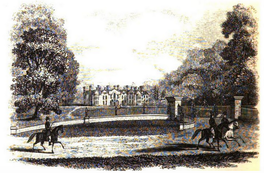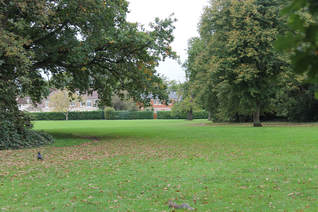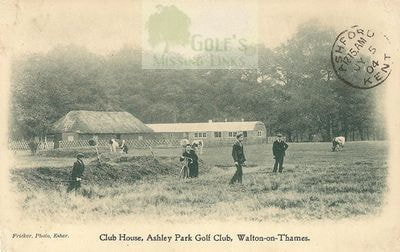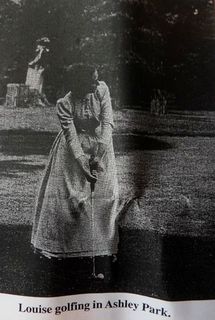Ashley Park Estate
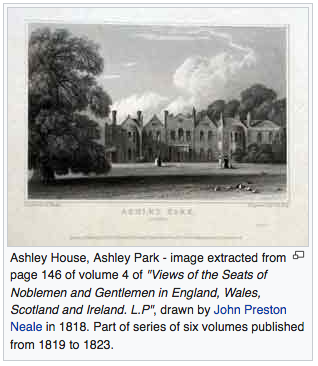
.In old writings, Ashley Manor is recorded originally as Asshlees or Asheley. The first records are dated 1433, when it was in the hands of Joan - widow of Robert Constable - who held it of the Crown. This was a relatively small manor measured at 16.5 acres (0.067 km2) at its earliest but was later extended. It is believed to have been mainly woodland with some lawns and fields. The manor was one of those incorporated into set of manors (the 'honour') of Hampton Court under the passing of the Hampton Court Manors or Manors of Hampton Court Act, 1539.
The construction of the first properly documented "Ashley House" was by Lady Jane Berkeley in 1602-5 and it was altered over the centuries until demolition between 1920 and 1925. Ashley Manor escheated to the Crown before and after Berkeley's ownership as was common of many manorial estates in that period.
Tenancy of the manor and Walton Lee and Walton Meads were granted by James I of England to Henry Gibb in 1625 and described with the lands belonging to King Henry 8th, and annexed to Hampton Court. It was subsequently granted by letters to Roger Yonge, by King Edward 6th. Queen Elizabeth and King James I made similar grants to several parties.
In the reign of King James I, Ashley was the seat of Christopher Villiers, Earl of Anglesea, a younger brother of the Duke of Buckingham. He died in 1624. Charles, his son, married but died without an heir in 1659, at which time Ashley Park was the residence of his grandmother, the Countess, who had remarried Benjamin Weston.. The Countess died on April 12th 1662 and was interred in a vault belonging to the estate, in St Mary's Church, Walton.
In 1669, Lord Henry Arundell lived here, followed by Sir Walter Clarges, and others until Sir Richard Pyne (Lord Chief Justice of Ireland). It was purchased from him in 1718 by Richard Boyle, Viscount Shannon. He died here in December 1740, and was also buried in Walton church and where a Roubiliac monument was erected to his memory. It's still there today and well worth a visit. Read all about ST MARY'S.
Grace Boyle, his daughter and heiress, was married to Charles Sackville, Earl of Middlsex. She died before her husband, in 1763, and bequeathed the estate to her cousin, Col. John Stephenson. After his death, in 1786, it came into the possession of Sir Henry Fletcher, the maternal nephew of the Countess of Middlesex. He was created a Baronet on 20th May 1782, was MP for Cumberland for 40 years and died in April 1807, also buried in St Mary's church. He was succeeded by his son, Sir Henry, who died on 10th August 1821. The property stayed in his family until it was bought by Sassoon David Sassoon (British businessman, banker and philanthropist.) shortly before his death in 1867; his grandson Sassoon Joseph Sassoon and young family were the final owners of the house. It was demolished between 1920-1925
Taken from: A Topographical History of Surrey, by E.W. Brayley assisted by J. Britton and https://en.wikipedia.org/wiki/Ashley_Park
The construction of the first properly documented "Ashley House" was by Lady Jane Berkeley in 1602-5 and it was altered over the centuries until demolition between 1920 and 1925. Ashley Manor escheated to the Crown before and after Berkeley's ownership as was common of many manorial estates in that period.
Tenancy of the manor and Walton Lee and Walton Meads were granted by James I of England to Henry Gibb in 1625 and described with the lands belonging to King Henry 8th, and annexed to Hampton Court. It was subsequently granted by letters to Roger Yonge, by King Edward 6th. Queen Elizabeth and King James I made similar grants to several parties.
In the reign of King James I, Ashley was the seat of Christopher Villiers, Earl of Anglesea, a younger brother of the Duke of Buckingham. He died in 1624. Charles, his son, married but died without an heir in 1659, at which time Ashley Park was the residence of his grandmother, the Countess, who had remarried Benjamin Weston.. The Countess died on April 12th 1662 and was interred in a vault belonging to the estate, in St Mary's Church, Walton.
In 1669, Lord Henry Arundell lived here, followed by Sir Walter Clarges, and others until Sir Richard Pyne (Lord Chief Justice of Ireland). It was purchased from him in 1718 by Richard Boyle, Viscount Shannon. He died here in December 1740, and was also buried in Walton church and where a Roubiliac monument was erected to his memory. It's still there today and well worth a visit. Read all about ST MARY'S.
Grace Boyle, his daughter and heiress, was married to Charles Sackville, Earl of Middlsex. She died before her husband, in 1763, and bequeathed the estate to her cousin, Col. John Stephenson. After his death, in 1786, it came into the possession of Sir Henry Fletcher, the maternal nephew of the Countess of Middlesex. He was created a Baronet on 20th May 1782, was MP for Cumberland for 40 years and died in April 1807, also buried in St Mary's church. He was succeeded by his son, Sir Henry, who died on 10th August 1821. The property stayed in his family until it was bought by Sassoon David Sassoon (British businessman, banker and philanthropist.) shortly before his death in 1867; his grandson Sassoon Joseph Sassoon and young family were the final owners of the house. It was demolished between 1920-1925
Taken from: A Topographical History of Surrey, by E.W. Brayley assisted by J. Britton and https://en.wikipedia.org/wiki/Ashley_Park
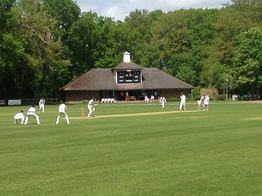
ASHLEY PARK CRICKET CLUB
Sassoon Joseph Sassoon took a very keen interest in sport, particularly involving himself and the Walton-on-Thames villagers in establishing good quality cricket club on the estate grounds, still in existence today. Read all about WALTON CRICKET CLUB.
Sassoon Joseph Sassoon took a very keen interest in sport, particularly involving himself and the Walton-on-Thames villagers in establishing good quality cricket club on the estate grounds, still in existence today. Read all about WALTON CRICKET CLUB.
|
ASHLEY PARK GOLF CLUB
Joseph Sassoon also soon caught the 'golf bug' and decided to create a nine-hole course on land lying between Ashley Road, Station Avenue, Hersham Road and Stompond Lane. To bring this to fruition he called upon the services of his gardener, James Albert Steer*. Then aged 29 he laid out the course during 1890, using only hand and horsepower. The shortest hole was 120yds and the longest 410yds, standard hazards included trees, ditches and bunkers. Play commenced in the Autumn of 1890 with Steer becoming the pro/green-keeper, later becoming equally proficient in club and gutta percha ball making. Joseph Sassoon became the club's President with Arthur Read as Captain. Both entry fee and annual subscription were 2 guineas. 100 members were soon found later rising to 125. A thatched building on the estate not far from the station served as an early changing room but the Ashley Park Hotel, recently built on land opposite the station (sold by Joseph to a brewery concern) soon became the head-quarters of the club and could naturally accommodate visiting golfers. Joseph became a proficient player as did his second son David and sister Louise (photograph of her playing). The club continued to be a success until 1905, when Joseph, needing to realise some extra capital to continue financing his house and estate upkeep, plus the education of his many children, decided that the sale of the land nearest the station, ( the golf course), for residential development was the only answer. As he did not want the existing members to be inconvenienced he approached the Viscount (later Earl) Iveagh (head of the Guinness family). Iveagh had some time earlier purchased the nearby Burhill House and estate. The house had recently become available for development following the death of the incumbent, the Dowager Duchess of Wellington. In brief 300 acres, sufficient for two 18 hole courses and the use of the house as club HQ and part dormy house was negotiated on a 28 year lease. All the members of Ashley Park Golf Club were offered membership when the new Burhill Golf Club opened the following year. Prince Alexander of Teck became the President and Arthur Read was elected as its first Captain. A final dinner marking the end of the Ashley Park Golf Club was held in May 1907 at the Ashley Park Hotel, presentation of a gold watch was made to Arthur Read for his services as Captain for all seventeen years of the club's existence. An illuminated address signed by all members was given to Joseph Sassoon - "The members of Ashley Park Golf Club desire to express by this address their deep sense of gratitude to their President, Joseph Sassoon Sassoon J.P. for his unexampled generosity in allowing them the free use of his Park for golf during the last seventeen years and also having acted as their President for this long time, and for countless acts of kindness shown to them since the club was started in 1890". Taken from: http://www.golfsmissinglinks.co.uk/index.php/england/south-east/surrey/800-sur-ashley-park-golf-club-walton-on-thames |
